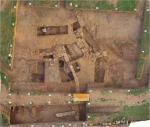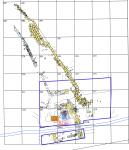Summary (English)
This year, Amsterdam University continued excavations in the area of Poggio dei Cavallari. The investigations concentrated on area 2 where a number of trenches, formally only partially excavated, were reopened and extended (see Fig. 1: margins of the 2018 excavation area indicated in purple) with the aim of further investigating the ancient structures present there.
In area 2, work concentrated on the south trenches partially excavated in 2004, 2005, and 2016-2017. Several structures had been identified that were attributed to a road branching-off the main road that crossed the city from east to west. A large trench 12.50 × 3.00 × 2.50 m was opened to extend the excavation area on the south side (Fig. 1-2). The aim of this extension was to find the southwards continuation of the exterior east wall of the building investigated in 2017 and its south wall. In fact, the continuation of wall 3 was found at a depth of c. 2.50 m bringing its measurable length to c. 12 m. Towards the south, it continued into the south wall of the trench.
Beyond this wall built of tufa ‘lionato’, there was a short section of an east-west wall built of large white tufa blocks at a slightly higher level (wall no. 5). This was the only surviving wall of a probably later phase.
In the western part of the area, a north-south wall (wall no. 6) was uncovered in trench 261A constituted by a row of large tufa ‘lionato’ blocks resting directly on natural that sloped upwards to the west. It is not clear whether this was the external west wall of the room with the cobblestone threshold. The continuation towards the north of wall no. 6, which should have been present in trench 261, was not found, only natural was seen in the small trench dug along its presumed line.
Excavation also continued inside the room with the floor made of cobblestones and pottery fragments in a sandy make-up. A sondage in the floor along the inside of the west wall revealed traces of Iron Age occupation. A burnt layer c. 0.10 m thick overlay a deep layer full of pottery fragments datable to the first half of the 7th century B.C. Together with fine wares, the layer also contained numerous fragments of large dolia, metal fragments and slag, evidence of metalworking activities.
The research on the Casale del Giglio property continues to be of importance as it has provided solid evidence of urban occupation in the zone below the necropolis that was thought to have been lost after the intense agricultural activity of the 1970s. The excavations have also provided much new information regarding the adaptation of the archaic architecture to the irregular natural landscape and its exploitation for the construction of a road network during the phase of archaic urbanisation. At the same time, it became clear that the same zone was occupied in the Iron Age as attested by an infant burial found in 2013 in excavation area 3, which dates to the first quarter of the 7th century B.C., by the various layers dating to the 7th century B.C. both in area 2 and area 3, and by the presence of numerous postholes in the underlying natural (2013-2017).
- Marijke Gnade – Università di Amsterdam, ACASA
Director
Team
- Desiré Steures - Università di Leiden
- Loes Opgenhaffen - Università di Amsterdam
- Martina Revello Lami - Università di Amsterdam
- Jesús García Sánchez – Università di Leiden
- Jitte Waagen - Università di Amsterdam
Research Body
- Università di Amsterdam, ACASA
Funding Body
- Azienda agricola ‘Casale del Giglio’






![Download [PDF]](/excavation/skins/fasti/images/results/download_sml.png)
